Beaumontia is an outstanding scrambling shrub or climbing plant for larger gardens. It has beautiful large white flowers and large deep green leaves with prominent veins. Naive to the Himalayas, it is happiest in warmer climates, but will tolerate some short lived light frosts in temperate climates. If pruned after flowering, this plant makes a nice shrub, or it can be trained over a trellis or other support. Make sure the plant is held by a sturdy structure because it grows large and heavy....plants can grow to 10 metres tall. Provide a sunny position ( or semi-shade ) and a well-drained soil and you will be rewarded with a great display of flowers in Summer, and also late winter to spring if in the right position. You can cut some flowers for inside and the strong seductive perfume will fill the room. The plant is quite useful, having some medicinal uses and a strong fiber is obtained from the young twigs. I took these photos in North Sydney, where the plant was trained over the entrance to a residential garage. 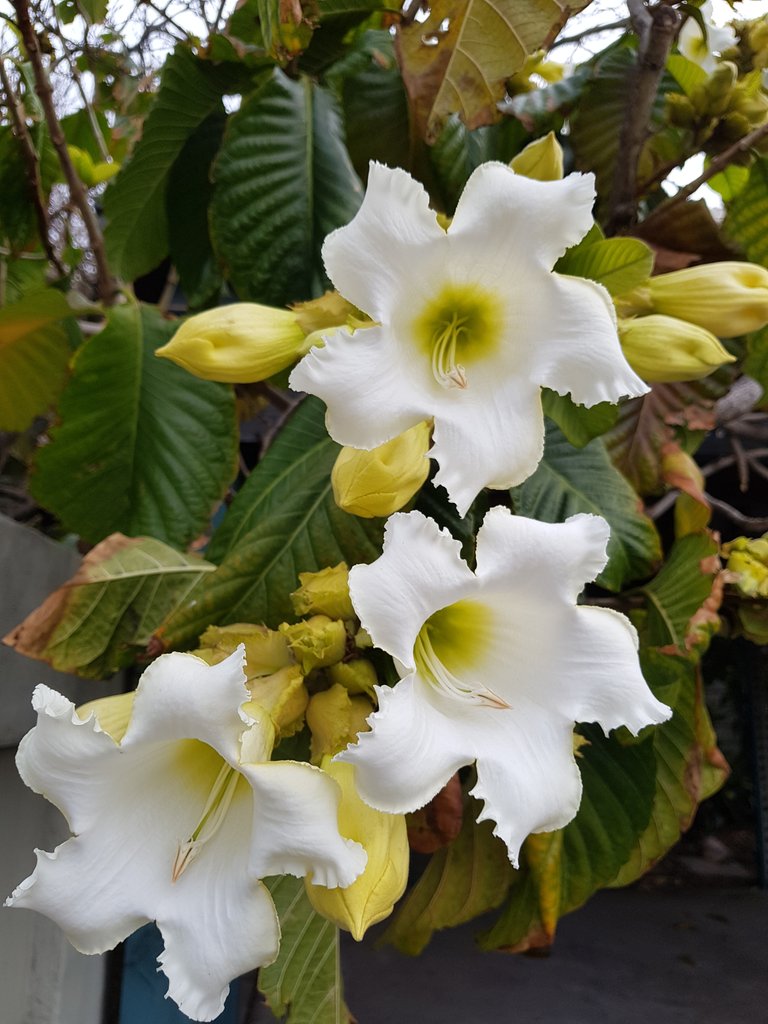
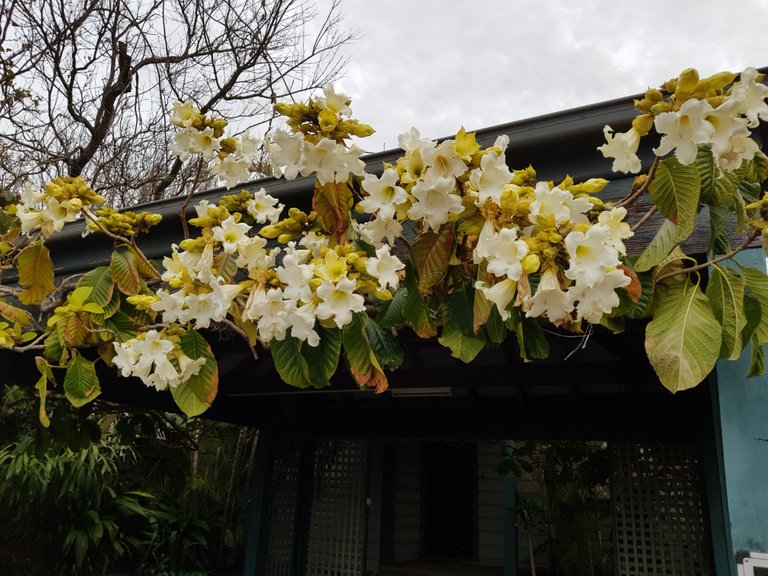
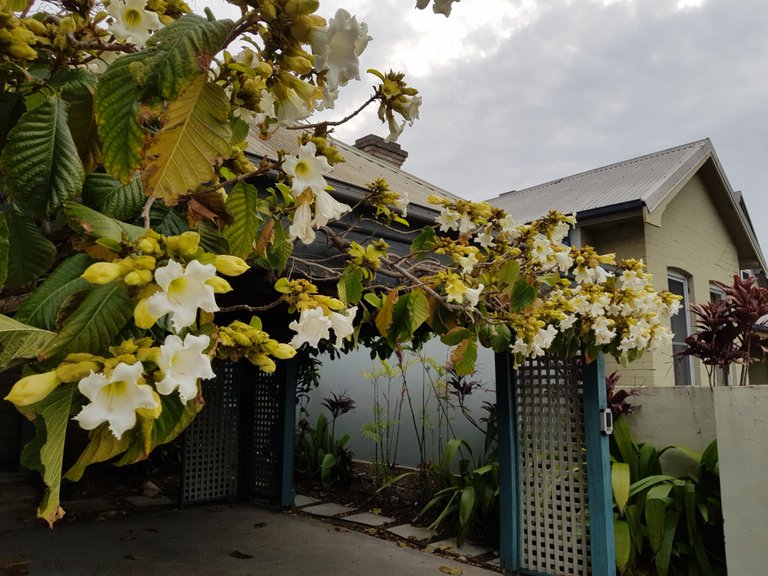
One of the most impressive climbing plants which also grows well in subtropical climates. A vigorous evergreen climber that can reach over 20 ft tall and as wide if a strong support is available. Very large leaves can reach 9 inches long and are a glossy green color with prominent veins and new growth has attractive brownish hairs. In late spring to early fall appear the terminal clusters of large (3-6 inch long by 4 inches wide) fragrant white flowers that are trumpet-shaped and resemble an Easter Lily.
Plant in full sun or light shade preferably in a rich soil and provide ample water. It is hardy to 28 degrees F and in cold years can be semi-deciduous. It dislikes heavy wet soil in winter. If pruning is required, as it often is because this plant can get rather large, do so just after flowering to promote new flowering wood for the following year.
Source: https://toptropicals.com/catalog/uid/Beaumontia_grandiflora.htm
Silly Sausage Award !! Very nice Pics, although i'm not sure that the last Pic is Beaumontia, it may be Mandevilla.
One of the most impressive climbing plants which also grows well in subtropical climates. A vigorous evergreen climber that can reach over 20 ft tall and as wide if a strong support is available. Very large leaves can reach 9 inches long and are a glossy green color with prominent veins and new growth has attractive brownish hairs.
In late spring to early fall appear the terminal clusters of large (3-6 inch long by 4 inches wide) fragrant white flowers that are trumpet-shaped and resemble an Easter Lily.
Plant in full sun or light shade preferably in a rich soil and provide ample water. It is hardy to 28 degrees F and in cold years can be semi-deciduous. It dislikes heavy wet soil in winter.
If pruning is required, as it often is because this plant can get rather large, do so just after flowering to promote new flowering wood for the following year.
Source
Fav. comment Award !! Nice choice of pics and information.
Rampant vine with arching, twining branches; climbs as high as 30 feet and spreads just as wide. Large (6- to 9 inches.), oval to roundish dark green leaves, smooth and shiny above, slightly downy beneath, give lush tropical look. From spring through summer, bears fragrant, trumpet-shaped, 5 inches-long, green-veined white blossoms that look like Easter lilies (Lilium longiflorum).
Does best in well-drained soil enriched with organic matter; regular feeding produces most lavish display of foliage and flowers. Prune after bloom to shape or limit size; flowers are produced on wood 2 years old or older, so keep a good proportion of old wood.
Hardy to 28F. Frost kills the vine to the ground, but it usually comes back from the roots. Use as big espalier on warm, wind-sheltered wall or train along eaves of house; sturdy supports are essential, since growth is heavy. Good choice for planting near swimming pools.
Source
Fav.comment Award !! Very nice choice of Pics, thanks.
Pictures cannot even begin to describe the sight of a mature Beaumontia in full bloom. A big plant can be covered with many large flowers.
Beaumontia does need mature to bloom,
it may take a couple of years before you see the flowers. To produce the best display, this heavy climber with large leaves will need a strong structure.
Without support the plant will form
a large mound. It can be grown in pots but will not get very big or produce many flowers like the ones grown in the ground.
Beaumontia is a tropical vine. It can tolerate a light frost for short periods but it is better to protect it if the temperature goes bellow freezing.
Rampant vine with arching, twining branches; climbs as high as 30 feet and spreads just as wide. Large (6- to 9 inches.), oval to roundish dark green leaves, smooth and shiny above, slightly downy beneath, give lush tropical look.
Resources
Lovely !
Beaumontia grandiflora, commonly called Herald s Trumpet or the Easter Lily Vine. It is native of the Himalayas. This beautiful vine can reach 10 to 30 feet tall but much more sideways. It makes nice cut flowers that can last for a long time.
Magnificent white flowers appear from spring to fall. The trumpet-like flowers measure from 4 to 6 inches wide. They are composed of a unique petal and each have a pale yellow stamen in their middle. The flowers have a light sweet smell.
Beaumontia is a climbing vine that can be very vigorous. The foliage is semi-evergreen. The leaves are glossy green on the upper surface and dark green and hairy underneath. They measure more than 8 inches long. The woody trunk and branches act like wires to enable the plant to grow in height. The plant produces oblong green fruits from the end of summer to fall. After the blooming season, the plant loses its leaves


Source
Great Pics, thanks !
An interesting rare perfumed plant is Herald’s Trumpet (Beaumontia grandiflora) which has wonderful large white flowers with a sweet tropical perfume. It is a vigorous woody climber which is native to the region from India to Vietnam and belongs to the same plant family (Apocynaceae) as Oleanders, Frangipanis and Mandevillas which typically bleed a white milky sap from cut stems.
Common name: Herald’s Trumpet
Botanic name: Beaumontia grandiflora
Climate: Will grow best in the warmer zones of Australia, north of Coffs Harbour, NSW. It prefers sub-tropical and tropical conditions to thrive and can look miserable in areas where temperatures fall below 10
https://www.burkesbackyard.com.au/fact-sheets/in-the-garden/flowering-plants-shrubs/beaumontia/
Beaumontia grandiflora is a magnificent scrambling plant native to Subtropical India. It has large evergreen leaves and large, white, fragrant, trumpet – shaped flowers which can bend down the branches with their weight!
As Beaumontia can attain up to 5m or more in height, it is definitely not suitable as a house plant and is only suitable for the largest of conservatories or glasshouse. Beaumontia is named after the Beaumont’s family who lived at Bretton Hall, Yorkshire.
Come and see ours in flower now in the Subtropical House.
https://www.birminghambotanicalgardens.org.uk/beaumontia-grandiflora/
Very beautiful plant - Beaumontia grandiflora, and great photos!
I really liked your photos, @ctrl-alt-nwo
source
Very beautiful flowers grow in your country !
Thank you for every time you surprise us with such bright flowers and plants.
Beaumontia grandiflora is really a beautiful plant. They are looking very beautiful as beautiful white coloured flowers and large green leaves.
Source
Source
Source
I also appreciate your brilliant photography of Beaumontia grandiflora. Thanks a lot sir @ctrl-alt-nwo for always sharing beautiful flowers and plants.
Beaumontia grandiflora is a magnificent scrambling plant native to Subtropical India. It has large evergreen leaves and large, white, fragrant, trumpet – shaped flowers which can bend down the branches with their weight!
As Beaumontia can attain up to 5m or more in height, it is definitely not suitable as a house plant and is only suitable for the largest of conservatories or glasshouse. Beaumontia is named after the Beaumont’s family who lived at Bretton Hall, Yorkshire.
.

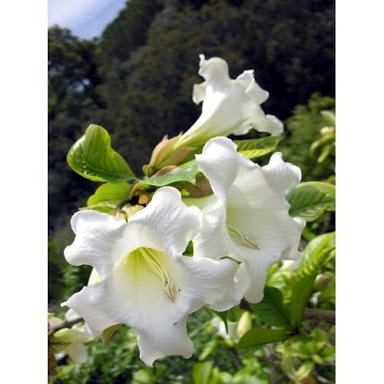.jpg)
Source
.
Source
Source
Beaumontia grandiflora, commonly called Herald’s Trumpet or the Easter Lily Vine is native of the Himalayas. This beautiful vine can reach 3 to 10 meters tall but much more sideways.
They are composed of a unique petal and each have a pale yellow stamen in their middle. The flowers have a light sweet smell. Beaumontia is a climbing vine that can be very vigorous.
Source
Source
The foliage is semi-evergreen. The leaves are glossy green on the upper surface and dark green and hairy underneath. Frost kills the vine to the ground, but it usually comes back from the roots.
It makes nice cut flowers that can last for a long time. Magnificent white flowers appear from spring to fall. The trumpet-like flowers measure from 10 to 15 cm wide.
Source
Use as big espalier on warm, wind-sheltered wall or train along eaves of house; sturdy supports are essential, since growth is heavy. Good choice for planting near swimming pools.
Text Source 1
Text Source 2
Beaumontia grandiflora is a beautiful plant. It forms a woody stem, clothed with leathery green leaves, and bears large, white, trumpet-shaped flowers in spring.
Sources
Planting is done in autumn or early spring, and wires are fixed to afford support for the shoots. Water is given freely during the summer, but less is needed in winter.
Source
Thanks a lot for the beautiful flowers article.
Some temperate people say it’s our climate that makes me so. I’m over-reactive in the presence of obvious glamour – hot and bothered and over-boiled. They’re referring to both my temperament and my vulgar taste in plants. There could be something in that. We generally raise a good sweat in garden labour in the heat of tropics and sub tropics , so want something “big” back for our efforts. A grand “thank you” from nature, writ large.
The sweet little spring bunches of dainty pansies, petunias, geraniums, pelargoniums, daisies and similar pretty contenders on our garden club bench competition this month paled into insignificance when I spied the magnificent Beaumontia grandiflora branch in their midst; big, brash, white blooms, its heady seductive perfume permeating the hall. I was smitten – as I generally am with a statement item.
https://gardendrum.com/2013/10/01/vulgar-gardening/
Your 1st pic is Brugmansia (Angels Trumpet) - not the same plant. The 3rd one is Allamanda. Can be confusing with common names though !
How beautiful this flower is when planted in our homes. Not only beautiful, but fragrant and flowering throughout the year.
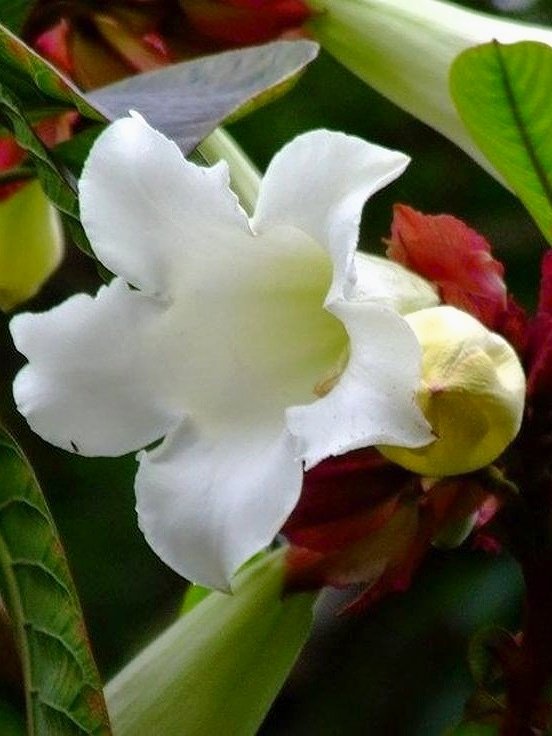
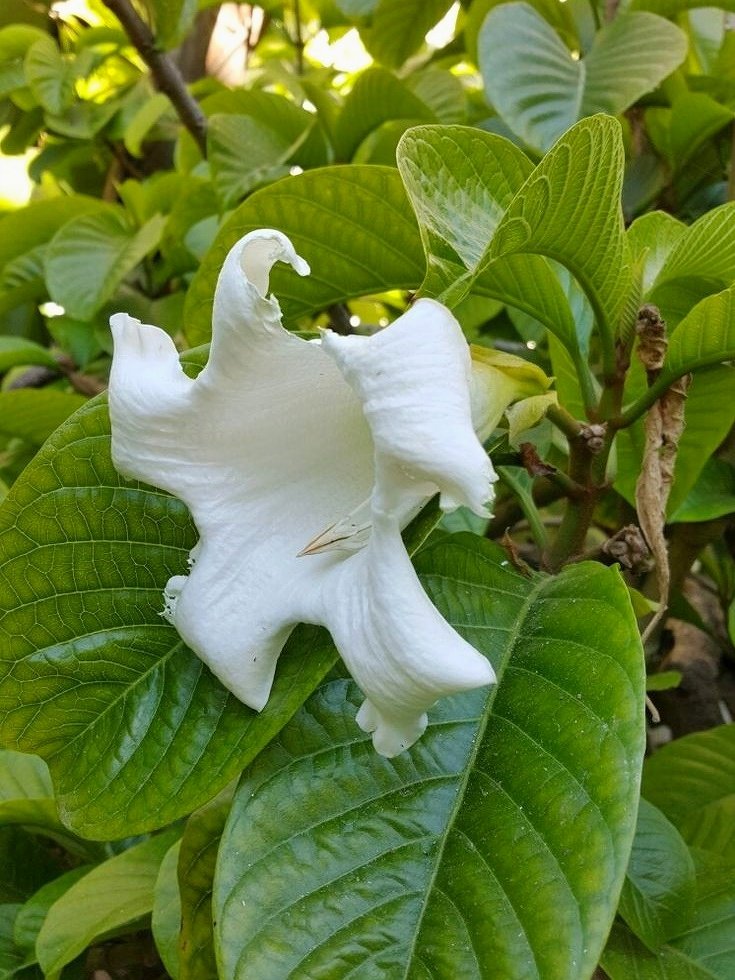
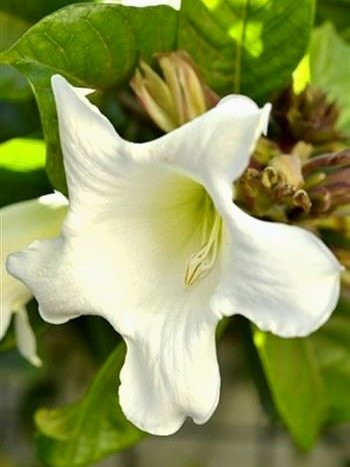
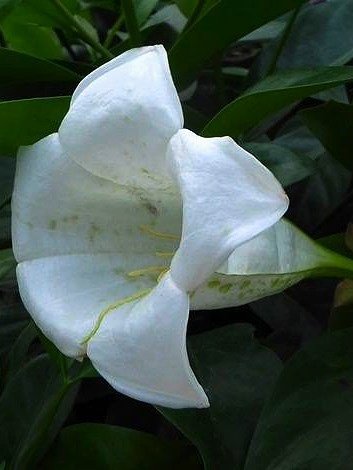
Beautiful trees with many flower arrangements make this flower very special. Understandably, one stalk can consist of several flowers and flowering on all tree tops.
This plant is also good when used as a plant in pots or plants in the garden around our house.
This flower is rarely sold in florists, maybe even in some exhibition events, only one or two sell this plant. Still rare and classy.
Sources:
http://www.indotanaman.com/2017/11/25/bunga-esterlily-vine/
Description
Beaumontia plants are often rampant climbers and vines. They are mostly evergreen, though in subtropical gardens Beaumontia grandiflora loses many leaves in winter. Leaves are large, smooth and opposite with sticky white sap.
The large white fragrant flowers are borne in corymbs terminal and in the leaf axils. The calyx is 5-lobed and the corolla is dark funnel-or bell-shaped with 5 lobes. Stamens are attached near the base of the corolla tube and have slender filaments with arrow-shaped anthers. They are very showy when in full bloom and are regarded as among the most outstanding vines of the world.
The fruits comprises a pair of thick woody follicles.Beaumontia species are cultivated as ornamental plants, with Beaumontia grandiflora widely grown by the nursery trade. They prefer good soil, adequate water and hot moist conditions. They are found planted and trained as vines in subtropical climate gardens, Species[2]
Beaumontia brevituba Oliv. - Guangxi, Hainan
Beaumontia grandiflora Wall. - Vietnam, Thailand, Laos, Myanmar, Assam, Bhutan, Bangladesh, Sikkim, Nepal, Guangxi, Yunnan; naturalized in Central America
Beaumontia jerdoniana Wight - S India, Andaman Islands, Myanmar
Beaumontia khasiana Hook.f - Yunnan, Assam, Myanmar.
(Sourse)Beaumontia - Wikipedia
https://en.m.wikipedia.org › wiki ›
Beaumontia grandiflora is a substantial evergreen climber. Stem is woody with corroded smooth shoots, smooth juice streams from cut stems. Oppositely organized leaves are inverse, membranous-weathered, obovate to applaud elongated, unexpectedly sharpen generally smooth and bare, once in a while sparesely furry beneath, 15-30 x 7-18 cm.
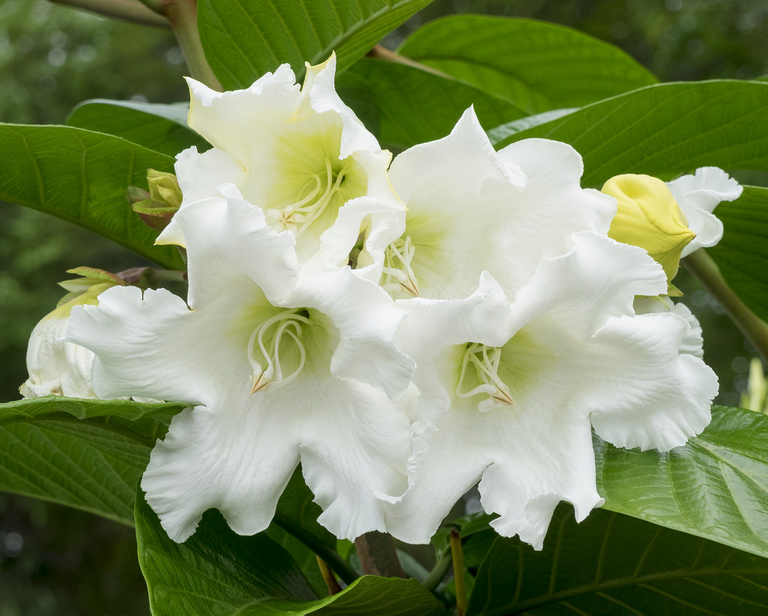
Leaf stalks are 1.25-2.5 cm long, shaggy. Sepals are upset lanceshaped, smooth, 3.5 cm long, frequently glandular inside, dull red or ruddy dark colored in shading. Blossoms are 7.5-12.5 cm long, chime molded, white or creamish, smooth or smooth, petals 5, 2.5 cm since quite a while ago, adjusted with a short point. Stamens are 5, remaining inside the bloom, substituting with the petals; anthers arrowshaped, connivent to the disgrace framing five sided cone, circle 5-lobed. Style is threadlike, shame fusiform. Follicles are elongated, thick, woody, turgid green. Seeds numerous ovoid or elongated, packed, contracted at the best. Blooming: March-April.
References
12 3
Common name: Nepal Trumpet Flower, Easter Lily Vine, Heralds Trumpet • Nepali: Swari phool

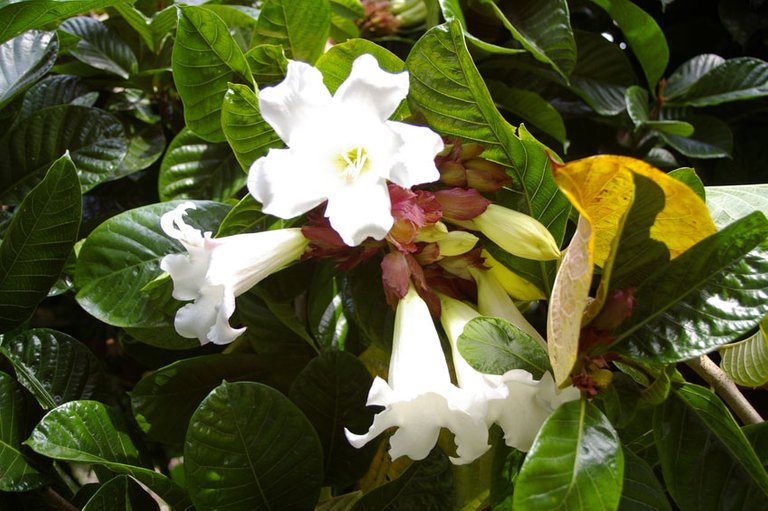

Botanical name: Beaumontia grandiflora Family: Apocynaceae (oleander family)
Synonyms: Echites grandiflora
Nepal trumpet vine is a large evergreen climber. Stem is woody with rusty velvety shoots, milky juice flows from cut stems. Oppositely arranged leaves are opposite, membranous-leathery, obovate to ovate-oblong, abruptly acuminate usually smooth and hairless, rarely sparesely hairy below, 15-30 x 7-18 cm.
Leaf stalks are 1.25-2.5 cm long, hairy. Sepals are inverted-lanceshaped, velvety, 3.5 cm long, often glandular within, dark red or reddish brown in colour. Flowers are 7.5-12.5 cm long, bell-shaped, white or creamish, hairless or velvety, petals 5, 2.5 cm long, rounded with a short point. Stamens are 5, staying inside the flower, alternating with the petals; anthers arrowshaped, connivent to the stigma forming five sided cone, disc 5-lobed. Style is threadlike, stigma fusiform. Follicles are oblong, thick, woody, turgid green. Seeds many ovoid or oblong, compressed, contracted at the top. Flowering: March-April.
http://www.flowersofindia.net/catalog/slides/Nepal%20Trumpet%20Flower.html
@ctrl-alt-nwo,
Wow the way they planted that flower plant, it made a wonderful decoration! I am little bit curious, Himalayas area has cool climate, so how could that be possible to see such well growth plant here?
Anyway, wonderful photography and useful information for all people who wish to decorate their gardens with this flower!
Cheers~
I guess the plant is adaptable to both climates.
The cheerful flowers look decent size. A grand addition to any garden.
Nice plant he/she has above the garage. I hope he drives convertible so he can every time smell the flowers while going through garage ;)
Wow it sire is a beautiful plant with very nice flowers :)
I do like the color mixtures of it
It sure is an elegant flower :)
Looks really beautiful have seen that one and it has its own presence which makes it amazing :D
This plant is amazing! Up to 10 meters high and with perfume! But this is too heavy for me to handle! I might try one by the fence!
Your comment section is always very colourful! Love it!!
Better than watching a movie!
Yes, the comments are amazing !!
Beaumontia plants are often rampant climbers and vines. They are mostly evergreen, though in subtropical gardens Beaumontia grandiflora loses many leaves in winter. Leaves are large, smooth and opposite with sticky white sap.
The large white fragrant flowers are borne in corymbs terminal and in the leaf axils. The calyx is 5-lobed and the corolla is dark funnel-or bell-shaped with 5 lobes. Stamens are attached near the base of the corolla tube and have slender filaments with arrow-shaped anthers. They are very showy when in full bloom and are regarded as among the most outstanding vines of the world.
The Beaumontia species are cultivated as ornamental plants, with Beaumontia grandiflora widely grown by the nursery trade. They prefer good soil, adequate water and hot moist conditions. They are found planted and trained as vines in subtropical climate gardens,
Source
A beautiful plant, my friend and it forms a woody stem, clothed with leathery green leaves, and bears large, white, trumpet-shaped flowers in spring. It must be grown in a house having a minimum winter temperature of 55 degrees or may be planted outdoors in the deep South. The name commemorates Mary, Duchess of Beaumont, a patroness of botany in the early 19th century. The plant is of rampant growth and a large greenhouse or conservatory is required for its cultivation: it is unsuitable for pots.
Cultivation. The best results are obtained by planting in a deep, well-drained bed of soil; a hole 3 ft. deep is dug, drainage is put in and covered with turf, the remainder of the hole being filled with equal parts loam, leaf mold and peat. Planting is done in autumn or early spring, and wires are fixed to afford support for the shoots. Water is given freely during the summer, but less is needed in winter; however, the soil must not be allowed to become quite dry; if this occurs the plants are injured seriously.
Pruning and Propagation. The side shoots should be shortened by two thirds after the flowers are over. Young shoots are inserted in sand or sandy soil in spring, in a propagating case kept close until the cuttings are rooted. They are then potted separately in small pots and subsequently in 5 or 6-in. pots, whence they are planted in their permanent quarters. Thank you @ctrl-alt-nwo
https://www.backyardgardener.com/garden-tip-articles/garden-guide/beaumontia-grandiflora-cultivation/
Beaumontia grandiflora (Easter Lily Vine) - A vigorous evergreen climber that can reach to 30 feet tall or more and as wide if a strong support is available. Very large leaves can reach 9 inches long and are a glossy green color with prominent veins and new growth has attractive brownish hairs. In late spring to early fall appear the terminal clusters of large (3-6 inch long by 4 inches wide) fragrant white flowers that are trumpet-shaped and resemble an Easter Lily.
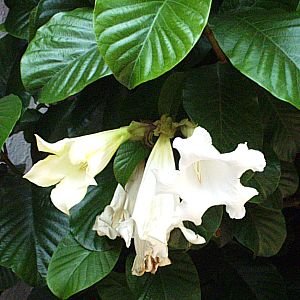
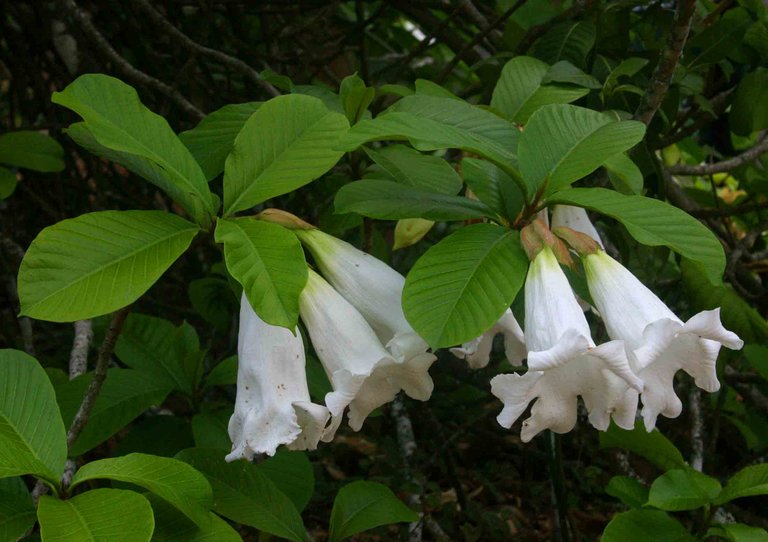
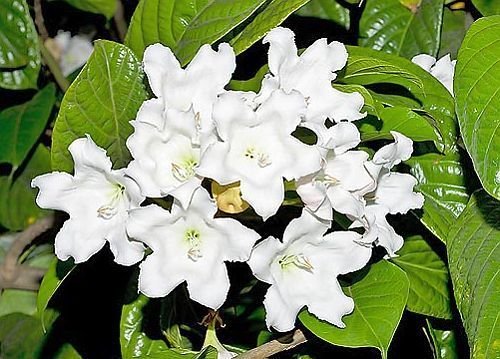
Plant in full sun or light shade preferably in a rich soil and provide ample water. It is hardy to 28 degrees F and in cold years can be semi-deciduous - dislikes heavy wet soil in winter. If pruning is required, as it often is because this plant can get rather large, do so just after flowering to promote new flowering wood for the following year.
Beaumontia is a genus of 9 species of evergreen woody vines from the East Indies and Asia with this species ranging from Nepal and Southeast Tibet and Yunnan south through Assam, Burma (Myanmar) and Southeast Asia where it grows in scrub and on rocks and trees in forests from 1,000 to 5,000 feet in elevation. The genus was named in honor of Mrs. Diana Beaumont (1765-1831) of Bretton Hall, Yorkshire who was described in the Curtis Botanical Magazine Volume 7 (New Series) in 1833 as "an ardent lover and munificent patroness of Horticulture". It was described by Dr. Nathaniel Wallich (1786- 1854) in 1824 from plants sent to him from Bretton Hall. Wallich, a Danish Surgeon, became the Superintendent of the Calcutta Botanic Garden and leading botanist in India at the time, having replaced the famed Scottish surgeon and botanist William Roxburgh (1751-1815). Roxburgh had previously named this plant Echites grandiflora from plants found in the forests of Eastern Bengal (India) near Chittagong and Sylhet but it had not been validly published and so Wallich's name stands as correct. Other common names for this beautiful vine include Heralds Trumpet and Nepal Trumpet Flower. The specific epithet comes from the Latin words 'grandis' meaning "great" or "large" and 'flora' meaning flower in reference to the large flowers of this species. This description is based on our research and observations made of this plant as it grows in our nursery, in the nursery garden and in other gardens that we have visited. We also try to incorporate comments received from others and appreciate getting feedback of any kind from those who have additional information about this plant, particularly if they disagree with what we have written or if they have additional cultural tips that would aid others in growing Beaumontia grandiflora.
https://www.smgrowers.com/products/plants/plantdisplay.asp?plant_id=238
Plant Details
From the Himalayas. Rampant vine with arching, twining branches; climbs as high as 30 feet and spreads just as wide. Large (6- to 9 inches.), oval to roundish dark green leaves, smooth and shiny above, slightly downy beneath, give lush tropical look. From spring through summer, bears fragrant, trumpet-shaped, 5 inches-long, green-veined white blossoms that look like Easter lilies (Lilium longiflorum).
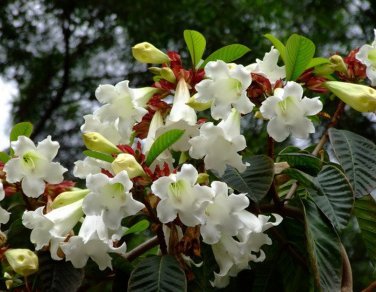

Does best in well-drained soil enriched with organic matter; regular feeding produces most lavish display of foliage and flowers. Prune after bloom to shape or limit size; flowers are produced on wood 2 years old or older, so keep a good proportion of old wood. Hardy to 28F.
Frost kills the vine to the ground, but it usually comes back from the roots. Use as big espalier on warm, wind-sheltered wall or train along eaves of house; sturdy supports are essential, since growth is heavy. Good choice for planting near swimming pools.
https://www.southernliving.com/plants/heralds-trumpet-easter-lily-vine
Beaumontia grandiflora, this plant is a plant with large flowers such as trumpets and soft scented. Still classified as rare plants.
Beaumontia Grandiflora has beautiful shaped flowers with bright white crowns and yellowish green petals.
Beaumontia Grandiflora blooms every time with adequate nutrition from leaf fertilization every 1 month.
Regular watering is done 2 times a day when it is just planted and once a day if it has started to grow.
Beaumontia Grandiflora can grow up to 5 meters, so it is necessary to do regular pruning.
Sources:
https://en.m.wikipedia.org/wiki/Beaumontia
Oh, yes, a beautiful plant @ctrl-alt-nwo! The beaumontia is an evergreen tropical shrub, originally from the Himalayas ( although some in the cooler climates lose their leaves in autumn ) with large dark green leaves ( some can be 22cm long) with prominent veins. It’s a heavy scrambling climber , so will need strong support, or it forms a large clump like a wisteria. It likes sun and shade and generally thrives in temperatures over 30 degrees C.
I love the sight of it climbing a fence or wall, spreading its gorgeous flowers to the heavens. It can grow to 10m tall, and can be invasive, so judicious pruning’s needed. This is best done after flowering to promote new wood for blooms to spring from. It can take a few years for a mature vine to come to full flower, but when it does, it ‘s an extended pleasure – from spring to late summer. Sometimes it flowers for the second time in autumn. As cut flowers, they are also long lasting. Mine were fresh for four days, with a daily change of vase water.
Suited mostly to warm climates, it can tolerate frosts for a short period. It produces an oblong green fruit from the end of summer. You can propogate from hardwood cuttings, using the layering method, best done in spring.
Also known as Herald’s Trumpet, that’s exactly the beaumontia’s soundtrack – a brassy announcement that a VIP is present and expects to be the centre of attention. The genus was named in honor of Mrs. Diana Beaumont (1765-1831) of Bretton Hall, Yorkshire who was described in the Curtis Botanical Magazine Volume 7 in 1833 as “an ardent lover and munificent patroness of Horticulture”. She was a wealthy and obsessive gardener, and grew a dazzling array of plants in a huge conservatory at her home, which once stood in the grounds of what is now Leeds University. It’s said she flaunted her beauty and wealth and was a social climber par excellence.
https://gardengrapevine.wordpress.com/tag/beaumontia-grandiflora/
This flowering plant is one of the best to put in one's garden or maybe on a trellis near the gate to welcome visitors with its alluring perfume and I wish that I had this one even in my backyard though @ctrl-alt-nwo
This is wonderful flower.

I shared on my twitter.
Great, thanks !
You are most welcome dear @ctrl-alt-nwo
These flowering plant is not available in my country @ctrl-alt-nwo because of the nature of our climate in here but it is really a beautiful plant for the garden or the border side of the house even.
Beaumontia grandiflora is a wonderful rare plant. It's also known as Herald's Trumpet. it's a is a large evergreen climber. Stem is woody with rusty velvety shoots, milky juice flows from cut stems.
Plant in full sun or light shade preferably in a rich soil and provide ample water. It is hardy to 28 degrees F and in cold years can be semi-deciduous - dislikes heavy wet soil in winter. Beaumontia Grandiflora can grow up to 5 meters, so it is necessary to do regular pruning.
image source
image source
Learn a lot about this beautiful plant. And eagerly waiting for your next post.
Very beautiful photos. Especially, the first photo - it turned out an excellent macro shot.
So beautiful large white flowers with big green leaves. Such a wonderful plant. I always interested to know about rare beautiful plants and flowers. And you always share beautiful Australian flowers and plants as i like your article.
image source
image source
Thank you so much sir @ctrl-alt-nwo for sharing about the beautiful plant.
you are really very talented person.because its expressed to doing your writing perfect skills and everyday showing new plant post in your blog.this time you selecting this white flower..i like it.white always freshness and pretty colour.i think that,we can knowing to read your daily post alots of nature beauty main part of flower matter. i am first time heard this amazing Beaumontia plant matter.this Beaumontia flower looks very impressible. its my new experience to see your flower. your describing style really very impressible.i like your every work.because your work anytime perfect and real.everyday i am got alots of new idea of various kinds of flower.flower always main symbol of nature beauty. this Beaumontia obviously outstanding climbing plant for large gardens and its beautifull large white flowers that deep green leaves with prominent veins. i think that white flower very attractive flower and its will tolerate some short lived light frosts in temperate climates .you really capture very fantastic flower plant of north sydney.but my country not available this plant.you pic up this flower its just marvelous.you capturing this photo proper style.its very big quality one of them you.if when my country i see this fantastic plant obviously i am doing growing my house garden this amazing flower plant any house roof. your showing beaumontia plants white flower just beautifull.thanks to sharing for your awesome creativity.i am always attracted them.i want you stayed anytime live long happily in your whole life.i wish that you success being your future and your all dreams comes true.may god bless you.my best wishes anytime with you.all the best.keep it up..take care yourself and best of luck of your great work.. my good friend.. @ctrl-alt-nwo
Beaumontia grandiflora (Easter Lily Vine) is an energetic evergreen climber who can reach 30 feet in height or more and in width if there is strong support. Very large leaves can reach 9 inches in length and have a glossy green color with prominent veins, and a new growth has attractive brownish hair. At the end of spring until early autumn, there appear terminal clusters of large (3-6 inches long by 4 inches wide) fragrant white flowers that have the shape of a tube and resemble Easter Lily

https://www.smgrowers.com/products/plants/plantdisplay.asp?plant_id=238
@ctrl-alt-nwo
That is Wonderful Flowers Plant and this is useful article. the perfect work.
thanks for sharing.
Plant Details
From the Himalayas. Rampant vine with arching, twining branches; climbs as high as 30 feet and spreads just as wide. Large (6- to 9 inches.), oval to roundish dark green leaves, smooth and shiny above, slightly downy beneath, give lush tropical look. From spring through summer, bears fragrant, trumpet-shaped, 5 inches-long, green-veined white blossoms that look like Easter lilies (Lilium longiflorum).



Does best in well-drained soil enriched with organic matter; regular feeding produces most lavish display of foliage and flowers. Prune after bloom to shape or limit size; flowers are produced on wood 2 years old or older, so keep a good proportion of old wood.
Hardy to 28F. Frost kills the vine to the ground, but it usually comes back from the roots. Use as big espalier on warm, wind-sheltered wall or train along eaves of house; sturdy supports are essential, since growth is heavy. Good choice for planting near swimming pools.
https://www.southernliving.com/plants/heralds-trumpet-easter-lily-vine
Last Pic is Mandevilla.
Pleased to know about the Native Himalayas plant Herald's Trumpet. The plant's scientific name is Beaumontia grandiflora. It's an large evergreen climber. It's large green leaves and white flowers make it gorgeous.
photo source
photo source
I always learn about various kind of beatiful fowers and plant from your every post. Thanks for always sharing beautful Australian flowers.
I think the first plant is Mandevilla.
Very interesting plant, It is a pity that only weak frosts it withstands. I learned that in addition to medicinal properties (a remedy for rheumatism), he still has two uses. A very strong fiber is made from its stems and ropes are weaved from it. The juice of this plant is poisonous, if you lubricate the tip of the arrow with this juice, even a light wound will be fatal.
Congratulations @ctrl-alt-nwo!
Your post was mentioned in the Steemit Hit Parade in the following category:
Thanks !!
Thanks for the interesting plants. That's what I found out.
Beaumontia as a vine, with the help of pruning can be grown like a shrub
Kutrovye family - Apocynaceae
It grows in the mountain forests of Southeast Asia, China, India. Named after Diana Beaumont (1765-1831), the English patroness of gardening Yorkshire.
There are only 9 species in the genus. The most popular in floriculture are large-flowered Beaumontia (Beaumontia grandiflora) and Murton (Beaumontia murtonii)
Very unpretentious
At home, up to 1.5-2 m, in nature - up to 6-10 m
Very high, outdoors up to 5 m per season
Perennial plant. In folk medicine of South-East Asia, the extract of roots and leaves is used as an external remedy for the treatment of rheumatism. Of the young branches of beavertry, a super strong, pure white fiber is obtained, which is used for weaving ropes and ropes.
Milky juice was used as a poison component for poisoned arrows. Flowers have a very pleasant smell
Poisonous as many other representatives of the family kutrovyh. Contains cardiac glycoside oleandrin
http://happyflora.ru/view_post3.php?latter=622
Like always you captured some nice flowers. I have to look for them when I´m back in Australia.